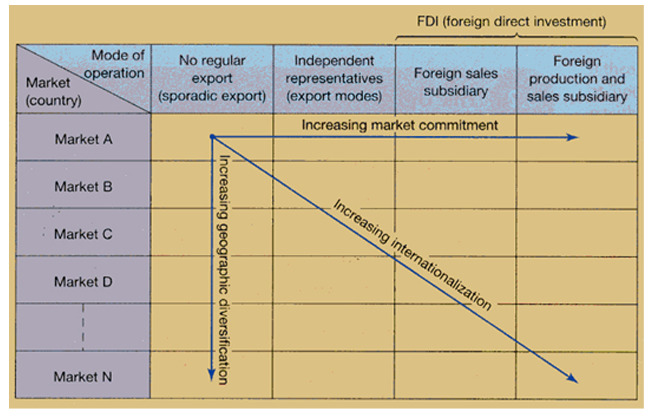Experience curve is the systematic reductions in the production costs that occur over life of a product. There is a relationship between the scale of production and the size of the unit cost of the product, known as the effect of experience. Graphical representation of experience effect (created on the basis of cumulative production and average cost) is called experience curve. A number of studies show that a product’s production costs decline by some characteristics about each time accumulated output doubles. E.g. in aircraft industry, where each time accumulated output f airframes was doubled, unit costs typically declined to 80 percent of their previous level. That is the production costs of the fourth airframe would be 80 percent less of the production costs for the second airframe, the eighth airframe’s production costs is 80 percent less of he fourth’s, the sixteenth’s airframe costs is 80 percent less of the eighth’s Continue reading
Global Business Environment
The international/global business environment can be defined as the environment in different sovereign countries, with factors exogenous to the home environment of the organization, influencing decision-making on resource use and capabilities. The international business environment includes social, political, economic, regulatory, tax, cultural, legal, and technological aspects.
Internationalization Concept -The Uppsala Internationalization Model
Internationalization consists of standardized products or service through globally standardized marketing and production processes that target standardized customer needs. Internationalization can be described as the process of increasing involvement in international operations. Another definition denotes internationalization as the process of adapting firms’ operations (strategy, structure, resources, etc) to international environments. Both definitions emphasize the crucial fact that internationalization needs an overall support from the organisation as it is changing the environment to expand in various manners the process mostly consists of macro factors to evolve. The Process of Internationalization Internationalization fundamentally alters the price-setting strategies of domestic economic agents. This is true for agents operating in product markets, factor markets and financial markets. At a micro level, internationalization directly alters pricing behavior by deepening product and factor markets. More potential buyers and sellers imply greater competition and a reduction in excess returns. At a macro level, internationalization also has the Continue reading
Economic Impacts of Deficit Financing
Deficit financing can be regarded as a necessary evil which has to be tolerated, at least in the developing economies; only to the extent it can promote capital formation and economic development. This extent of tolerance is called the “safe limit of deficit financing”. This safe limit shows the amount of deficit financing that the economy can absorb and beyond which ‘inflationary forces’ may be set in motion. The economic impacts of deficit financing are: Deficit Financing and Price Level There are two opinions regarding the effect of deficit financing on the price level especially in a developing country. According to one view, deficit financing need not be inflationary in character especially if it is used during the peace time. The advocates of this view argued that: In a developing economy the existence of non-monetized sector will absorb the issue of new currency and shrink in its size over a Continue reading
The Effects of Financial Liberalization
Financial Liberalization refers to deregulation of domestic financial market and liberalization of the capital account that implies removing the ceiling on interest rates. When it is in a liberalized system the competition between the different lending institutions for the deposits will increase interest rates on deposits which will increase the deposits. The availability of credit will increase and this will cause an increase in investment growth. The stages of growth increases activity in the financial markets that makes the introduction and the development of financial institutions. It is argued that financial institutions, by gathering and evaluating information from borrowers, allow the allocation of funds for investment plans to become more efficient and therefore encourage growth and investment. Banks have a role in the process of development. These banks gives the chance for individuals to hold their savings in the form of deposits, so lowing the need to hold them in Continue reading
Sustainable Development Goals (SDGs) – An Overview
The United Nations Sustainable Development Goals (SDGs) is a program that was created by the United Nations. Its aim is to achieve an all-round development globally through having the desire to achieve such factors as; hunger and poverty reduction, having many people access both clean and affordable energy, improvement and provision of proper health services, industrialization, innovation and both economic and infrastructural development and many more objectives totaling to seventeen. In other words, it offers a sincerely comprehensive apparition of the future. These sustainable development goals were created and adopted in 2015 September, after the period for which the achievements of Millennium Development Goals (MDGs) were terminated in 2015. However, some of the objectives were substantially met. Nevertheless, some remain unfinished business, to enable the overall global sustainability and prosperity for all by the year 2030. The achievement of these development goals will involve many stakeholders, including the public sector, Continue reading


